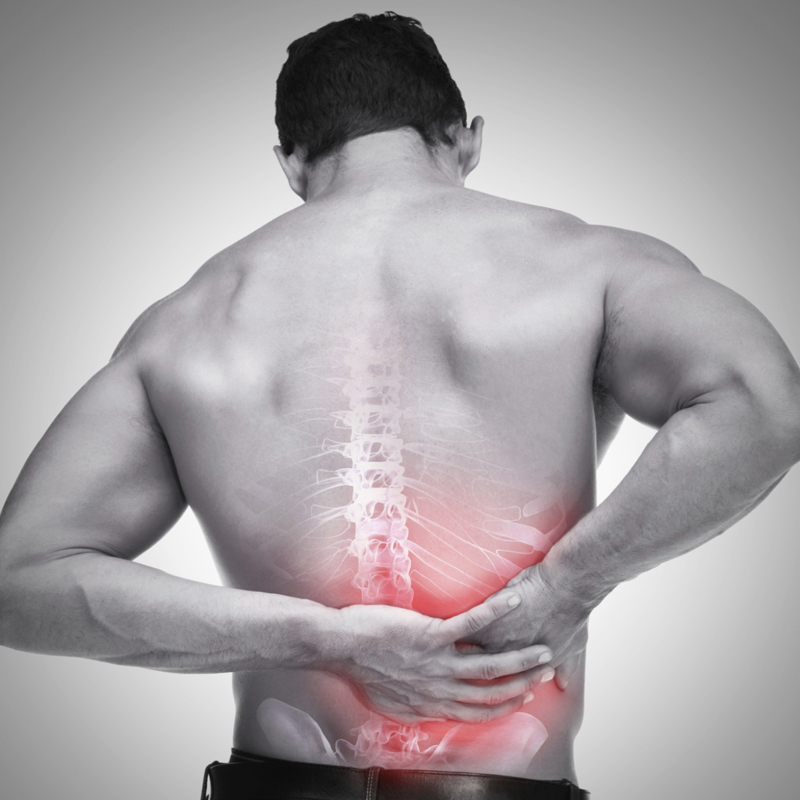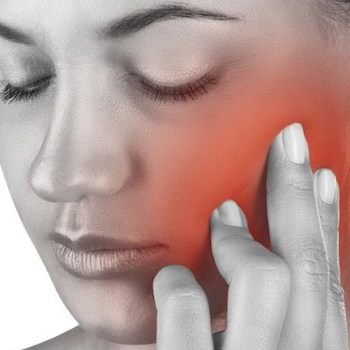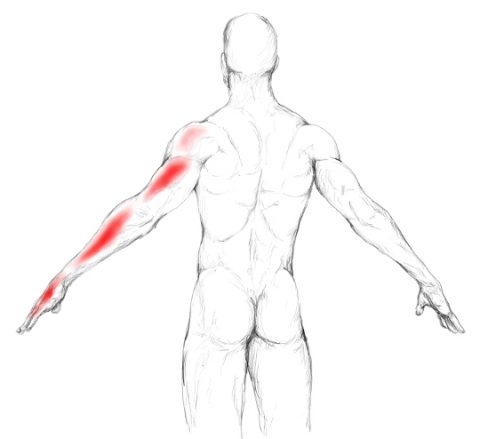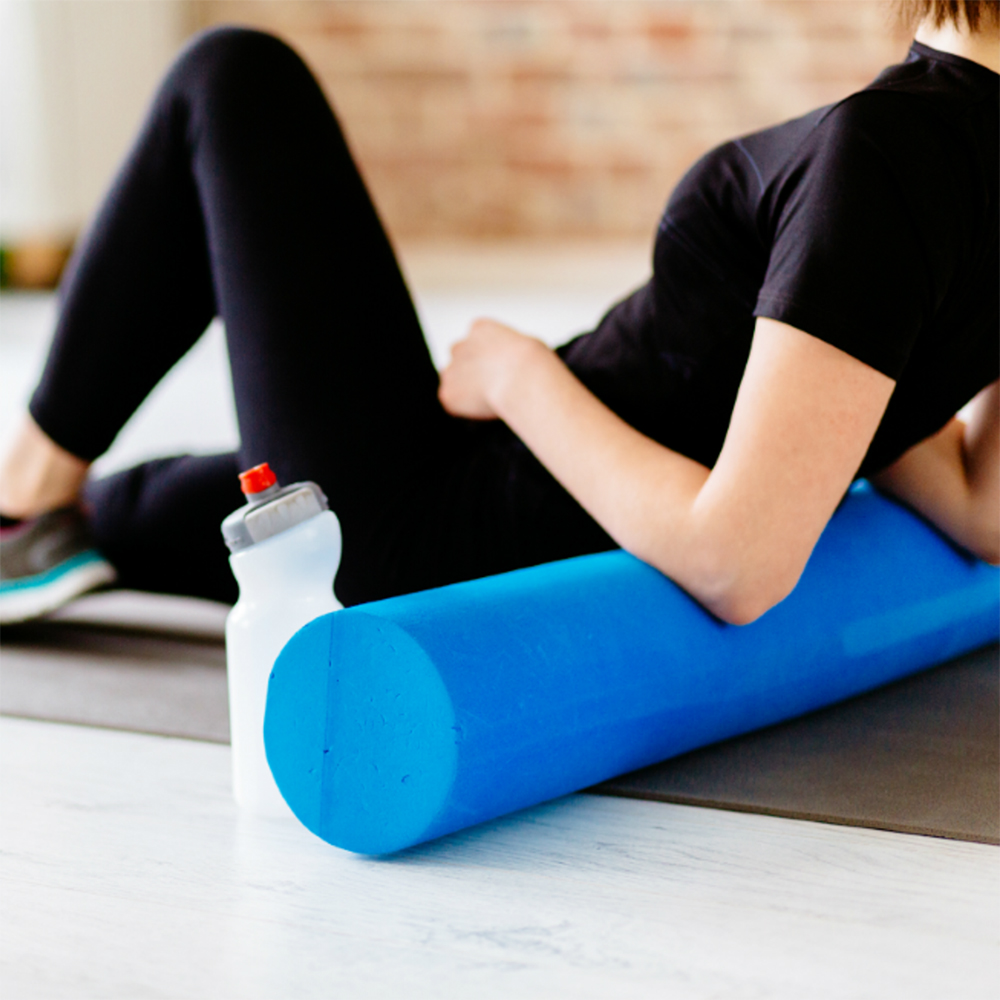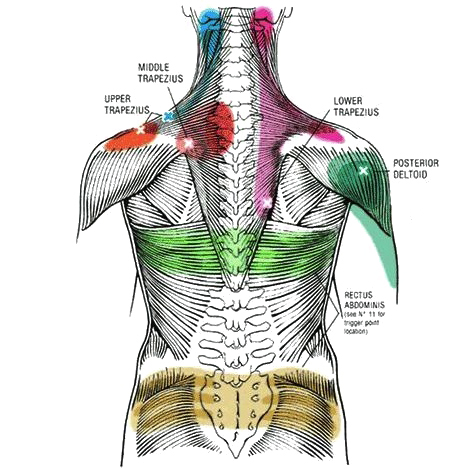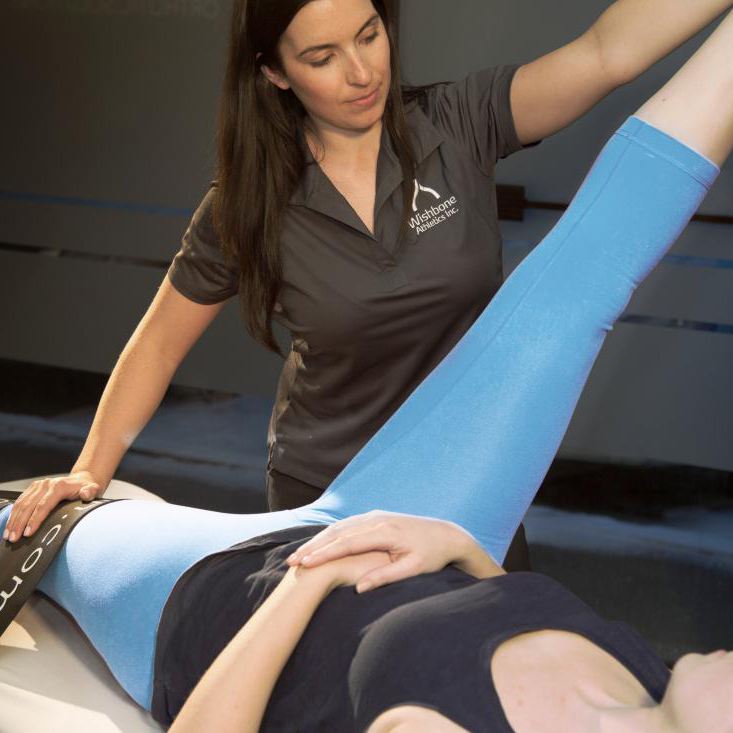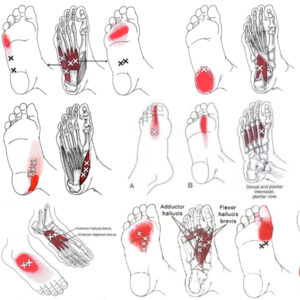
Many things outside your feet can make them hurt. For instance, myofascial dysfunction some of the muscles of the calf or hip can cause problems with your feet.
However, some foot problems really do orginate in the feet. In addition, the ‘intrinsic’ muscles of your foot can reinforce problems in your calf – and vice versa.
Many things outside your feet can make them hurt. For instance, myofascial dysfunction some of the muscles of the calf or hip can cause problems with your feet. However, some foot problems really do orginate in the feet. In addition, the ‘intrinsic’ muscles of your foot can reinforce problems in your calf – and vice versa.
Unfortunately, this is a complicated topic that can only be simplified by breaking it into small sections. Yet, the audience for 5-6 articles on specific foot muscles might be limited. So, I have summarized all the available info on both superficial and deeper intrinsic foot muscles. We will just call them foot muscles most of the time going forward.
Foot Pain – Intrinsic Muscles – Trigger Point Activations
Foot Pain Intrinsic Muscles of the Foot – Superficial
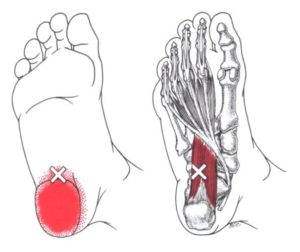
The patterns are similar to some of your calf muscles. Although the calf muscles and foot muscles can and do activate trigger points in each other, your foot muscles also need to be considered separately.
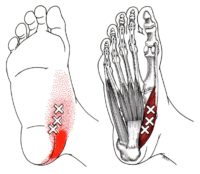 You can activate trigger points in the foot muscles from bruising, stubbing or breaking your toes. Fractures and sprains, especially if they require you to wear an immobilizing boot, can activate trigger points in the superficial and deep short toe flexors.
You can activate trigger points in the foot muscles from bruising, stubbing or breaking your toes. Fractures and sprains, especially if they require you to wear an immobilizing boot, can activate trigger points in the superficial and deep short toe flexors.
If your shoes have a tight toebox or vamp (the top of upper and crossing the top of your foot) this they restrict toe movement. Shoes that are generally too tight also restrict movement of the interossei. This overloads the foot muscles and can activate trigger points in them.
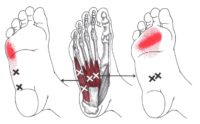 Structural variations that cause misalignment of your ankle or hyperpronation, such as Morton’s Foot Syndrome, can activate and perpepuate these trigger points.
Structural variations that cause misalignment of your ankle or hyperpronation, such as Morton’s Foot Syndrome, can activate and perpepuate these trigger points.
If you are have, or think you might have gout or pseudo-gout it is important to manage it effectively. These diseases deposit crystals into the joints of your toes and restrict movement. This can activate trigger points and cause additional foot pain; intrinsic muscles of the foot can be treated effectively
More details about the anatomy and function of these muscles are in the Extras section at the end of this article.
Foot Pain Intrinsic Muscles of the Foot – Deep
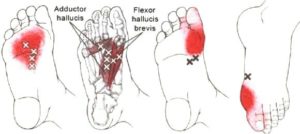
Not only that, but we have muscles in between the bones of our foot. These muscles are called lumbricals and interossei. You can overload and activate trigger points in the muscles because of imbalances in your calf muscles. 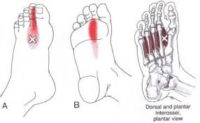
This reduces the stability of your foot and the strength of your drive in propelling a step, especially in running or other sports.
Shoes that are too small (short) are more likely to activate and perpetuated trigger points in the interossei.

…is a full topic in its own right. See my article on Plantar Fasciitis (PF). In most cases of PF, the symptom are actually caused by microtears in the junction between the Quadratus Plantae (QP) and the heel bone.
We often read about something like this occuring where the plantar fascia attaches to the bone. Either way, this causes inflammation at the site of the tears. Sometimes, a bone spur also develops in the small “tent” made in the covering of the bone where the tiny tears happened.
At the most basic level, PF happens because of a combination of over-use stress on foot itself and muscular imbalance in the your foot and calf. The QP is one those muscles and is really deep in the sole of your foot. In addition, the foot muscles that help flex and spread your toes can stress this same spot near the heel. If you suddenly increase running or jumping activities your can overload the your deep toe flexors. This can activate trigger points through your foot muscles.
Other muscles in the calf may also contribute to this pattern. Conventional treatments have included everything from massage to steriod injections to surgery. For most of us, these approaches do not work. Myofascial treatment of PF focuses on rebalancing the muscles and fascia through your feet and calves. I also recommend complete rest of the muscle. If you can avoid even walking more than a few steps for a couple of days – do it! Acoustic compression with ultrasound is particularly effective for deep foot muscle trigger points
Myofascial Treatment of Foot Pain, Intrinsic Muscles
Self Compressions
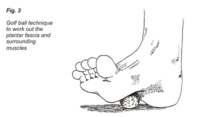 You will find that both a rolling pin and a golf ball are helpful tools. Use the golf ball roll back and forth along the toe flexors and quadratus plantae.
You will find that both a rolling pin and a golf ball are helpful tools. Use the golf ball roll back and forth along the toe flexors and quadratus plantae.
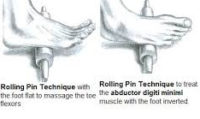 You can also use it to roll more across the ball of your foot the target the adductor hallucis, which pulls your big toe to the center.
You can also use it to roll more across the ball of your foot the target the adductor hallucis, which pulls your big toe to the center.
In addition, you can use a rolling pin to reach muscles on the outside edges of the feet, such as the aBductors of your big and little toes. These muscles are used to spread/splay your toes.
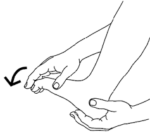 You should stretch your flexors and extensors. Begin seated and gently flex and extend the toes. Then grasp the toes and gently flex them. Work all the toes together. For this and the remaining stretches, try this technique: Alternate gently extending/flexing against resistance, relaxing and ‘picking up the slack’. Try this three times, slowly.
You should stretch your flexors and extensors. Begin seated and gently flex and extend the toes. Then grasp the toes and gently flex them. Work all the toes together. For this and the remaining stretches, try this technique: Alternate gently extending/flexing against resistance, relaxing and ‘picking up the slack’. Try this three times, slowly.
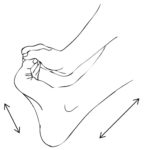 However, many people experience cramping when stretching the extensors. You would fix that with a flexor stretch.
However, many people experience cramping when stretching the extensors. You would fix that with a flexor stretch.
You can deepen this stretch a bit by using a towel under your foot. The towel will pull up against the toes and will allow you to carefully apply a bit more force.
Because some of these muscles are quite deep they are more difficult to reach with massage techniques than some other muscles in the foot. They are not very responsive to kinesio taping, traditional ultrasound or other superficial techniques. However, we easily can target trigger points in these muscles with acoustic compression therapy.
Avoid walking or running on uneven surfaces. Walking on sand presents special challenges and results in a significant amount of toe flexing or gripping.
If you are a runner, take a break. This includes treadmills and ellipiticals. Initially, substitute swimming, rowing or cycling for aerobic activity for a while. You may also be working on deconditioned leg and foot muscles during this time.
If possible, resume running on an elliptical. This reduces strain on your toes. Then, you can move up to a treadmill or other flat, level surface. Avoid slanted or uneven surfaces.
Avoid gripping the floor from wheeled desk chairs with your toe flexors.
If you are have gout or pseudo-gout it is important to manage it effectively.
Check your shoes that you wear regularly:
- Avoid spike heels completely
- Make sure shoes are not generally too tight.
- Try to make sure the sole and heel have some spring.
- The toe box should be large enough to move your toes
- The vamp (the lower, middle part) of your shoes should have enough room to reduce cramping.
- The soles of your shoes should be flexible. Avoid most Dansko’s and other shoes with thick plastic, wood block or platform soles.
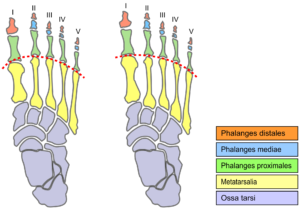
This means that your first metatarsal (the bone behind your big toe) is relatively short. Morton’s Foot Structure changes the way your foot is supported. Therefore, it can contribute to myofascial pain and dysfunction by increasing overload on key muscles. This common skeletal variation makes your foot want to pronate. So it makes sense that muscles that have a significant job to provide stability would be unhappy. A simple correction with a posture control insert is usually all that is needed.
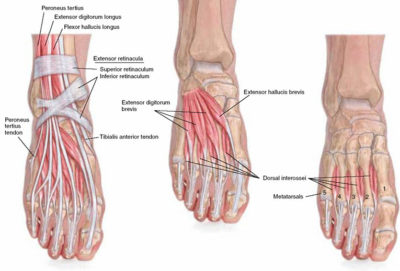 You may find it helpful to review a little bit of the anatomy to understand how these muscles work.
You may find it helpful to review a little bit of the anatomy to understand how these muscles work.
The view from the top is simpler. You can see that the toes extensors cross the bones of the bone at an angle.
The deep interossei run between the bones of the foot. These are all superficial intrinsic foot muscles.
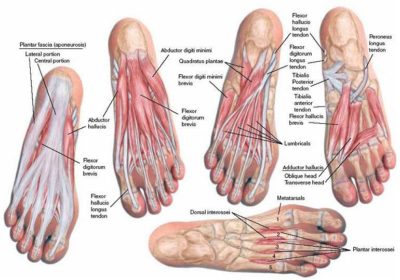 But the view from the bottom is incredibly complicated!
But the view from the bottom is incredibly complicated!
In this picture both the deeper and superfical layers of the muscles on the sole of the foot are shown pretty clearly.
Note that there are two layers of short toe flexors – the flexor digitorum brevis and the deeper lumbricals.
The lumbricals and the long toe flexor in your calf provide most of the power for toe flexion.
Your superficial and deep intrinsic foot muscles permit flexability to asborb shock and provide balance. However, they also provide stability and rigidity for propelling your body.
Of course, we need single-leg balance your foot we are on one leg, as in the middle of a walking or running step.
The intrinsic foot muscles also help you sense the ground. Also, the deeper muscles help you adjust to variations in terrain. Together the deep foot muscles make your forefoot rigid when your weight is on the ball of your foot.
Finally, if you have flat feet, your foot muscles help to maintain your arch.
Professional Treatment With Us
Take some time. Treat yourself. You deserve it.
Book a treatment this month and receive 20% off a three session package.
Janet was great. FANTASTIC person who knew how to treat and deal with my conditions. Very informative. Finally, someone who knew what I was talking about.
Really Good
It was interesting, and helpful for my IT band and hip
My experience was wonderful. Janet was very kind and attentive. I felt great after my session and would recommend to try it out.
The lady that assisted me was awesome! I suffer from fibromyalgia and when I left I felt like a brand new person! I plan to return when I get time!
Janet was great - knowledgeable and she found all my "hot spots."
Seriously, if you are looking for massage therapy that actually does your body good--that changes its function for the better and actually makes pain go away--then this is the place you need to come. Not Massage Envy. Not a chiropractor. You need trigger point from knowledgeable experts in the craft.
If your have pain in any part of your body this is the place to go. It focus on the muscles where the pain is. you will feel like a new person. Awesome will be returning. Thanks nice friendly and attentive
amazing!!!
I felt so much better after my appointment. Thank you and thanks for the self care tips!
Experienced therapist. Feel great after appointment...
Highly recommended!
What a great experience. The provider was able to recommend things I can do to improve my pain. Address issues I didn't even share with her that she was able to tell just by her exam and treating me for what i went for. Will be back. Feeling grateful
I spent so much money on chiropractors. This is much better. Everybody should try it out.
Beautiful, relaxing setting. Therapist was knowledgable and professional. I'll be going back. Thank you.
Janet is very informative. I loved that she explained which muscles/groups she was working on. I learned a lot about my posture and why some of my muscles are not activating. She also provided me with a list of considerations and excercises to improve my posture. I will be back!
Janet has a unique gift and talent in trigger point therapy. I’m definitely seeing her again!
I loved my experience. Janet is extremely knowledgeable in a vary wide variety of conditions. She is thorough and attentive. Makes you feel right at home!
It's like an hour of physical therapy (the good parts of P.T. where they massage you and stretch you). She also takes time to explain some ways to help your specific issues. Highly recommend!
Janet is very knowledgeable and informative. She thoroughly explains where you have weakness and what muscles are over compensating. She gives exercises, stretches, or everyday changes you can make to help you are progress on your own. I highly recommend a visit!
Janet was very knowledgeable and never in a hurry. She took her time explaining every little detail, great service
Felt much better after the trigger point massage, highly recommend.
Excellent
What About My Pain?
Clearly, everyone is different. Many of us have additional challenges and complications. Naturally, we tailor our treatment plans to the individual. However, there are common foundations in this work with everyone.
Fortunately, if you are having similar issues, you may find that a just few treatment sessions helps! We will identify and treat root causes of your individual case.
Clearly, everyone is different. Many of us have additional challenges and complications. Naturally, we tailor our treatment plans to the individual. However, there are common foundations in this work with everyone.
We are licensed professionals. In addition, we all have additional training and certifications in advanced techniques. For instance, this includes trigger point therapy, fascial stretching, neuromuscular and movement therapy. Also we offer kinesio taping, myofascial release, cupping, acoustic compression, self-care classes and more. In fact, we often combine several of these techniques into a single session..
Of course, no one wants chronic pain! Fortunately, can work together with you to help sort out the issues.
Click here or all us at 630-858-0000 today to make an appointment!
More info at: WestSubPainRelief.com
You can also take a picture of this QR code with another phone and share or view the entire article:
If reading from a pdf or printout, you will find links and videos at: https://WestSubPainRelief.com/foot-pain-intrinsic-muscles

